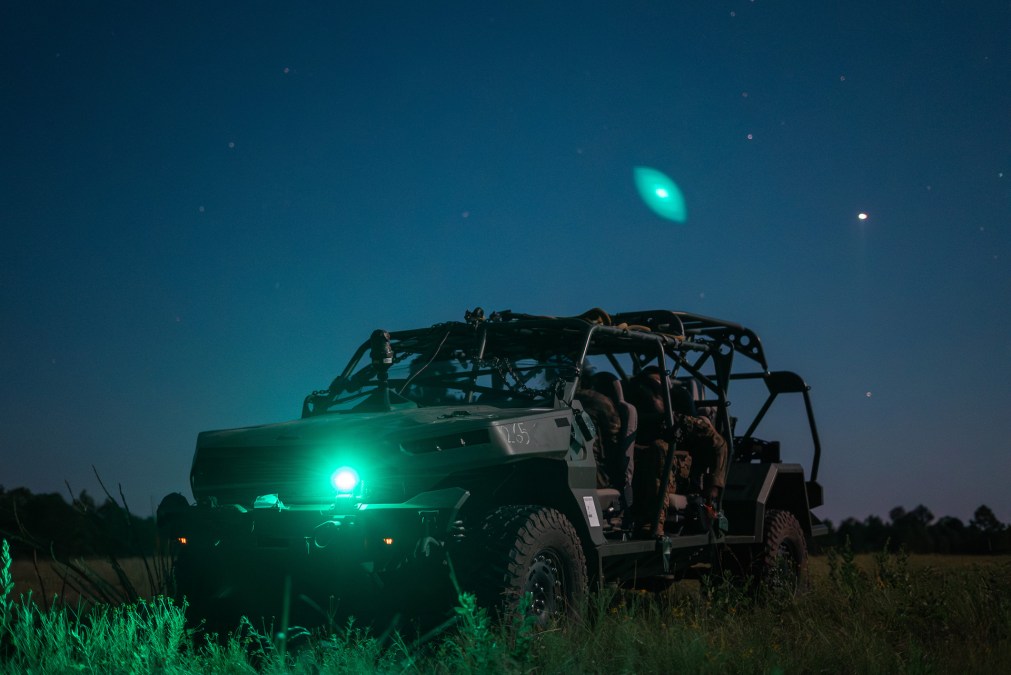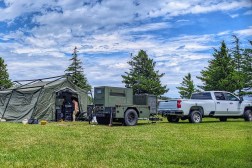Parallel tracks aim to improve current Army C2 while pursuing long-term options

This story is part two of a two-part series exploring communications upgrades and fixes the Army is pursing while using experimentation to modernize. Click here to read part one.
FORT JOHNSON, La. — The Army has been on a dual-track effort to improve command, control and communications capabilities in the near term, while devising a more long-term, materiel vision with new solutions.
The former — dubbed C2 Fix — is aimed at bolstering soldiers’ so-called “fight tonight” ability.
“Fix is we have a system, but it’s not acceptable that we’re just going to wait for the next thing,” Brig. Gen. Bryan Babich, director of the Mission Command Center of Excellence, told reporters during a recent visit to the Joint Readiness Training Center at Fort Johnson, Louisiana. “This right here is how we, in an integrated way, across the entire Army enterprise, focus on problems to deliver a C2 system that we could, God forbid, if we have to go out for the next fight in the near future.”
By contrast, Army Futures Command — along with program executive office for command, control, communications-tactical (PEO C3T) — is pursing a conception of what the future of command and control will be by breaking down silos between warfighting functions to provide commanders better situational awareness.
Previously, senior Army members outlined the inflection point the service finds itself in now where it’s seeking to alter the modernization effort it undertook roughly six years ago and move network complexity up to the division level and higher echelons.
Officials explained that the legacy capabilities and structures were too big and clunky to be successful on a future battlefield where formations will have to move rapidly or risk being targeted and killed.
“As we’re looking at C2 Fix, there are really three components that … we’re focused on for this. Number one, fixing the network. Number two, making our command post smaller and more survivable, though just as capable. Then third, moving simplicity to the edge,” Maj. Gen. Brett Sylvia, commander of the 101st Airborne Division, told reporters. “When you look at this configuration of this brigade command post with the large tents, multiple vehicles inside, you’ve got all these server stacks — and what that was a result of was that we had many systems that, in many cases, were stovepipes. You had an intel system that talked to itself, you had a fire system that talked to itself, you had a current ops system that was talking to itself, attempted to integrate these. The way that we overcame that was by making these large command posts with a lot of people inside them.”
To begin the “fix” initiative, the Army started with an ongoing assessment of the network. The Mission Command Center of Excellence established a team for field assessments of C2 systems that has been underway for roughly 15 months. The aim is to complete that work in the fiscal 2026-2027 time frame.
Part of this effort was spurred on by the determination by Lt. Gen. Xavier Brunson, commander of I Corps, that the current C2 system isn’t survivable and will put victory into question against an advanced adversary, according to officials.
The JRTC rotation of 2nd Brigade, 101st Airborne Division — a key modernization unit that’s testing new concepts for the Army — is part of that series of assessments. A previous one was Operation Lethal Eagle, a large-scale air assault that provided the opportunity to test new technologies, prototype reorganized structures and employ multi-domain fires, in April.
Now, the acquisition and operational community are working collaboratively together to drive solutions.
Such an integrated approach with operators is not new territory for the Army’s network community. Over the last six years as it sought to develop a modernized approach dubbed “capability sets” — a two-year process where each set builds upon the previous delivery for the Integrated Tactical Network made up of commercial off-the-shelf and program-of-record equipment — its program managers worked side-by-side with the operational community to test new capabilities and gain rapid feedback from soldiers to improve the delivery of new technology.
However, as the Army mapped out a more modernized approach, it realized the entire acquisition community needed to be integrated together — something the network team had also begun given the cross-cutting nature of the network and the need to be closely tied with others in the platform world to streamline integration of new kit and capabilities.
As a result, one person — Col. Shermoan Daiyaan, project manager for mission command at PEO C3T — is now in charge for leading the enterprise between eight program executive offices and 24 program managers to serve as the focal point of integration, something officials described as “fundamentally different.”
“It’s something that I’ve never seen in my career and it takes a level of cooperation,” Babich said of this integration across the Army.
As part of developing a “fix,” the service has created what it calls the “scroll,” a diagram rolled out across a series of tables measuring more than 10-feet long that details the traffic flow for any message that goes over the current architecture by echelon. The goal is to be able to visualize where the problems and gaps exist, isolate exactly what the Army wants to fix and provide a visualization for challenges and prioritization — because ultimately, officials don’t know what they don’t know.
This will allow the Army to be able to baseline the architecture for how units communicate and articulate to Army senior leadership where they might need to prioritize, because C2 Fix is about the near term and prioritizing the things that warfighters need in that time frame.
During experimentation and when upgrading these messaging and communications functions, officials can use the scroll for digital modeling and begin to take things out or add them without degrading the network before making the fixes.
The visualization also helps to transfer lessons across the rest of the Army, especially as other units are modernizing. The ambition is to take everything learned over the last four-to-five months with the 101st, render what that network looks like and pass on C2 Fix capabilities to other divisions. It provides the architecture the network team lands on and creates efficiencies so they don’t have several divisions in the Army trying to solve the problems individually in their own ways.
C2 Fix is serving as the bridge or “highway” for the next generation of command and control.
“C2 Fix is building the highway that will support next-gen C2,” Lt. Gen. John Morrison, deputy chief of staff, G6, said at the Defense News Conference Sept. 4. “The way I generally describe it is C2 Fix is getting after that network resiliency that will allow us to operate in a contested and congested environment, so that we can take a modern C2 apparatus that from the very basis that it’s been built has data integration built in, so we can operate at speed and at distance and make decisions faster than our adversaries — and putting that over this new, improved, resilient highway.”
He noted that C2 Next — the Army’s name for its next-generation capabilities — will be an integrated command-and-control apparatus that combines all the warfighting functions focused on data centricity, so commanders can have the information they need, when and where they need it, to act faster than their adversaries.
For C2 Next, the Army is working on developing an integrated data layer to connect all the systems for functions such as intelligence, fires, command and control, so it can be composed in a single place — which is a challenge because currently, many of these siloed functions are not connected to each other.
Officials want to pull in all the sensor data and information coming off of various platforms and put it on one screen.
The Army seeks to enable commanders to customize their dashboards, since every commander likes their own view and has different preferences.
Officials used the analogy of a smartphone where out of the box there are some stock applications but the user can download more apps that they want and customize their interfaces.
This, however, will be challenging under the developmental approach the Army is pursuing where it’s experimenting with three different vendors — Anduril, Palantir and Google — to build these dashboards that will display position and location information and provide much greater levels of situational awareness for commanders. Officials noted they are developing a governance structure to deal with the potential program management issues surrounding having more than one vendor from which commanders can choose custom dashboards.
“One of the things that we’re putting together in-flight is a governance system,” Col. Matthew Skaggs, director of tactical applications and architecture at Army Futures Command, said. “The difference between what we’re going to do now and how we’ve done it in the past as a federation of people that bring in different requirements, and it’s like a pyramid architecture … Setting the level playing field for what things look like, so then that’s getting kicked out [to] the industry and anybody can build to those specifications we’re welcoming.”
Officials noted the common data layer will provide the foundation for vendors that have cutting-edge technologies or solutions to pop them into the architecture — whereas now, there is no technical avenue to add new vendor capabilities to systems.






